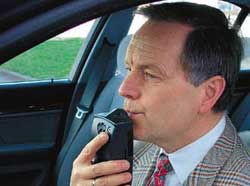On April 26, the American Automobile Association announced that it will use ignition interlocks to prevent drivers from starting their vehicles if their blood alcohol concentration exceeds legal limits. Currently, six regions in Canada and 43 states and cities in the U.S. require vehicles to be equipped with this device.
If the Ignition Interlock System (IIS) is installed, drivers must blow into a breathalyzer when entering the vehicle. If this action is not performed, the vehicle will not start. Once the device confirms a blood alcohol concentration of below 20 mg per 100 ml of blood, the engine can be started; otherwise, the ignition will remain locked, and the driver will have to wait until they are sober.
 |
Breath testing before starting the vehicle. (Azsafeharbor) |
In cases where the vehicle has already started, the system requires the driver to blow into the device at random intervals to prevent individuals from starting the vehicle and then drinking afterward. If the IIS requirements are not met or if the blood alcohol concentration is above the limit, the ignition will issue a warning, log the event, and activate devices such as flashing lights or horns until the engine is completely turned off. The cost of the IIS unit ranges from $200 to $20,000 depending on the type.
Lawmakers in New York are currently considering whether to mandate the installation of this device in all vehicles manufactured from 2009 onward. Meanwhile, Volvo and Saab, two Swedish car manufacturers, have already installed this system and wish to introduce their products to the U.S. The American Automobile Association, along with the nonprofit organization MADD (Mothers Against Drunk Driving), has been advocating for the legalization of IIS use in many states by garnering support from politicians.
While the U.S. and Canadian traffic safety agencies support and are developing a program encouraging drivers to install ignition interlocks, some individuals are strongly opposed, arguing that breath alcohol measurement methods are impractical and inaccurate. However, studies show that traffic accidents caused by drunk driving have decreased by 50% to 70% in many cities that mandate the use of this device.
MADD is a nonprofit organization founded in 1980 in the U.S. with the goal of combating drunk driving and promoting safe driving practices. The organization has received support from traffic safety agencies and sponsors and has made significant contributions to changing the poor habits of drivers. MADD currently employs over 100 people, primarily students.
Nguyễn Nghĩa



















































